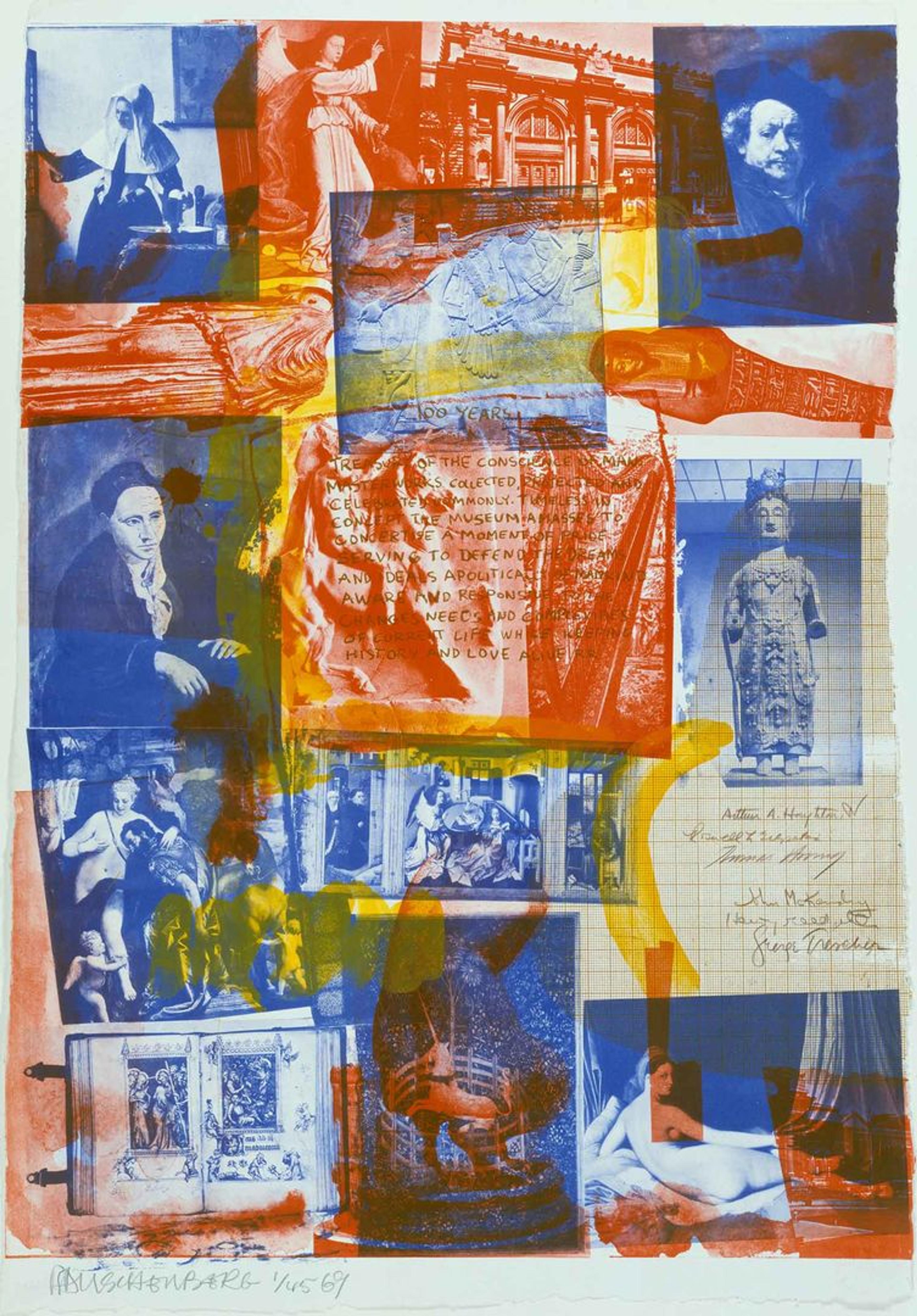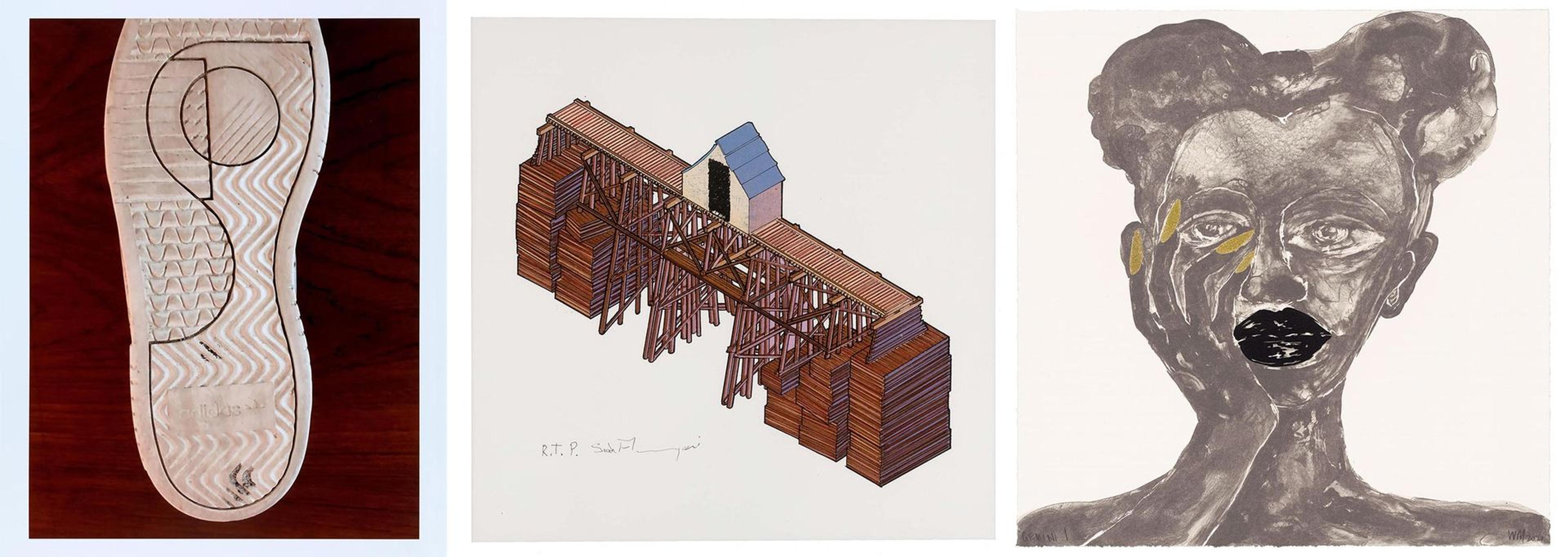In 2018, The Metropolitan Museum of Art embarked on the ambitious project of producing a print portfolio that would both celebrate the Museum’s 150th anniversary as well as reflect its role as a global cultural institution. To create this seminal collection, we invited a select group of twelve international artists with deep ties to the Museum to each make a limited-edition print. Earlier, Robert Rauschenberg created a monumental print Centennial Certificate MMA (1969), in honor of the Museum’s 100th anniversary. The Met 150 expands on this tradition, marking our next significant milestone, with the twelve artists given the freedom to fulfill their creative aspirations, something to which the diversity of print techniques and styles testify.

Robert Rauschenberg (American, 1925–2008). Centennial Certificate MMA, 1969. Color lithograph, Sheet: 36 x 25 in. (91.4 x 63.5 cm). Universal Limited Art Editions. The Metropolitan Museum of Art, New York, Florence and Joseph Singer Collection, 1972 (69.630)
Much has changed since The Met 150 was originally conceived and, as a result, the portfolio has taken on additional meaning. The production of The Met 150 spanned over two years, and the release was carefully orchestrated to coincide with the Museum’s anniversary celebration. It was an ambitious project, but nothing could have prepared the institution for the unforeseen tragedy of the global COVID-19 pandemic, which delayed all plans. While the world shut down, the artists persisted despite numerous difficulties. The portfolio thus became much more than a work of art celebrating The Met’s anniversary—it became, instead, an indelible reflection of our time and a testament to the power of art and the artists’ extraordinary commitment to create under adversity.
The twelve prints in The Met 150 vividly capture a variety of responses to the present moment in all its intricacy and contradictions.
The prints in The Met 150 encourage a new way of seeing and responding to the world in its complexity. Rather than a particular aesthetic, movement, or technique, they speak to a moment when artists reassess the possibilities for printmaking, redefining practices and challenging conventions. Several artists refer to printmaking’s rich history through their use of traditional methods; others combine various techniques, practices, and materials or employ new technologies to rethink what a print can be. The twelve prints in The Met 150 vividly capture a variety of responses to the present moment in all its intricacy and contradictions. This engagement with an ever-changing world is central to The Met’s mission and its aspirations for the future.

From left to right: Julie Mehretu. Arms, 2021. Drypoint in one color with chine collé on Somerset Satin White paper with Gampi White collé, 15 x 15 in. (38.1 x 38.1 cm) © 2021 Julie Mehretu; Vija Celmins. Fragment, 2021. Wood engraving on handmade Gampi mounted on Rives BFK paper, 15 x 15 in. (38.1 x 38.1 cm) © 2021 Vija Celmins; Jasper Johns. Artists at Work, 2021. Soft-ground etching with aquatint and open bite printed à la poupée in six colors on Hahnemühle Copperplate Bright White paper, 15 x 11 1/2 in. (38.1 x 29.2 cm) © 2021 Jasper Johns. All images © 2021 The Met 150
In Arms, Julie Mehretu employs an abstract language composed of multiple marks of various sizes and densities that, when layered, possess both a visual and symbolic power. In her wood engraving Fragment, Vija Celmins embraces formal and technical challenges to focus attention on details from the ocean surface, embracing aspects of abstraction while retaining recognizable elements. Throughout his career, Jasper Johns has returned to key motifs, which he famously described as “things the mind already knows.” In Artists at Work, he depicts three primary-colored stick figures holding small brooms like paintbrushes underneath a starry night sky. There, against the ghostly index of a pair of hands, a giant skull looms, calling forth a range of associations.

From left to right: Richard Serra. Composite for The Met, 2021. Etching with oil stick in one color on St. Armand White paper, 10 3/4 x 15 in. (27.3 x 38.1 cm) © 2021 Richard Serra; Kerry James Marshall. Untitled (Exquisite Corpse), 2021. Screenprint, woodcut, and linocut in six colors on Somerset Velet Softwhite paper, 15 x 15 in. (38.1 x 38.1 cm) © 2021 Kerry James Marshall; Ranjani Shettar. Alae alae, 2021. Woodcut and screenprint in eight colors, die-cut and folded, on Somerset White and Saunders Waterford papers, 15 x 13 in. (38.1 x 33 cm) © 2021 Ranjani Shettar. All images © 2021 The Met 150
Richard Serra’s Composite for The Met possesses deep, saturated black tones and a rich, sculptural texture. An etching made with oil stick, its remarkable physical presence challenges assumptions about the appearance and processes of printmaking. In Untitled (Exquisite Corpse), Kerry James Marshall makes reference to the Surrealist game both visually and in the title. However, rather than multiple artists each working on a designated section, unaware of the others’ activities, Marshall creates a vibrant composition divided into three distinct horizontal bands with three printmaking techniques—screenprint, woodcut, and linocut—in six colors. In a folded woodcut and screenprint in eight colors, Alae alae, Ranjani Shettar, translates effects of shadow and light, and the color and texture of natural events.

From left to right: Sarah Sze. Papillon, 2021. Screenprint in thirteen colors with embossment on Somerset Satin White paper, 15 x 30 in. (38.1 x 76.2 cm), folded to 15 x 15 in. (38.1 x 38.1 cm) © 2021 Sarah Sze; Xu Bing. Art for the People for The Met, 2021. Each seal functions as a QR code that links to a hidden message. Lithograph in six colors with relief print on Pescia Cream paper, 15 x 15 in. (38.1 x 38.1 cm) © 2021 Xu Bing; Ed Ruscha. Boom Town, 2021. Lithograph in four colors with embossment on Arches Cover White paper, 15 x 15 in. (38.1 x 38.1 cm) © 2021 Ed Ruscha. All images © 2021 The Met 150
Sarah Sze’s Papillon, an embossed screenprint in thirteen colors, is a dynamic composition filled with fields of color and photo-based elements that seem to expand beyond the limits of the paper, evoking sensations created by her three-dimensional assemblages and installations. Xu Bing engages the digital realm in Art for the People for The Met by employing QR codes located in the red seals that link to “hidden messages” on the Museum’s website. These stamps are interspersed with text rendered in “Square Word Calligraphy,” a writing system he invented in which the letters from English words emulate Chinese characters. Ed Ruscha has also engaged language, specifically the ways in which words function in various forms and contexts, as the ostensible subject of his art, as seen in his dynamic embossed lithograph in four colors, Boom Town.

From left to right: Gabriel Orozco. Simón’s Lines, 2021. Pigment Inkjet on Luster Photo Paper, 15 x 12 in. (38.1 x 30.5 cm) © 2021 Gabriel Orozco; Siah Armajani. House Above Bridge, 2021. Lithograph in seven colors on Pescla Cream Paper, 15 x 15 in. (38.1 x 38.1 cm) © 2021 The Estate of Siah Armajani; Wangechi Mutu. girl, 2021. Lithograph and screenprint in four colors with hand-applied gold pigment on Arches Cover White paper, 15 x 15 (38.1 x 38.1 cm) © 2021 Wangechi Mutu. All images © 2021 The Met 150
Gabriel Orozco’s work evokes everyday events and scenes, turning banal, often fragile objects and quotidian experiences into something poetic. Using the medium of photography and minimalist constructions, works like Simón’s Lines memorialize the ephemeral, capturing fleeting and unexpected moments. Siah Armajani expressed a range of interests in his art, including ontology, politics, mathematics, and engineering. In House Above Bridge, he combined motifs central to his art—the bridge and the house—to address concepts of movement, history, and the passage between spaces. In girl, a lithograph and screenprint in five colors with hand-applied gold pigment, Wangechi Mutu challenges constructions of globalization, gender, racism, and the legacy of colonialism by juxtaposing elements drawn from myriad sources to create a powerful and striking image.
Collaboration is at the heart of all printmaking. The Met 150 was fortunate to have the special partnership of Gemini G.E.L. LLC, the renowned workshop led by Sidney Felsen, that served as our printing and production partner. The project represents a coming together of dedicated colleagues from the Museum, artists’ studios, and printers, a community that played essential roles in the production of the portfolio. It is this sense of generosity, inspiration, and dedication that has been fundamental to The Met and its existence since its creation, and we owe these colleagues our deepest gratitude. Collectively, the portfolio provides a unique dialogue among a curated group of international contemporary artists—a portable exhibition in a box.
If you are interested in purchasing a portfolio, please contact Laura Einstein at (212) 650-2908 or Laura.Einstein@metmuseum.org.
